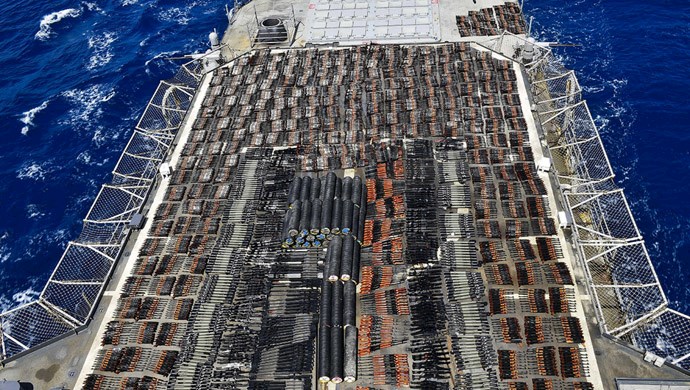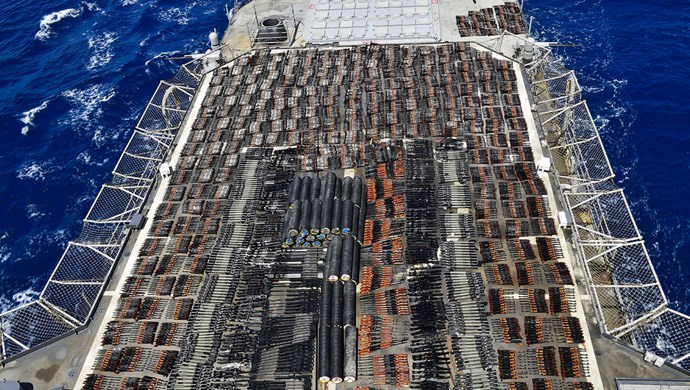Analysis by PMOI/MEK
Iran, May 31, 2021—How does the Iranian regime continue to support its proxy terrorist groups in Lebanon, Yemen, Syria, Iraq, etc. while it is under international sanctions?
The regime has set up an international smuggling system for arms and drug trafficking using the country’s resources and the money it steals from the people. In this system, major groups under Iranian regime supreme leader Ali Khamenei’s influence have devoted part of their job to managing this smuggling network. In fact, Khamenei is funding its regional interventions using mainly through the money his regime obtains from drug trafficking. It also uses the same weapons and explosives network to support the proxy groups under the regime’s influence.
The Revolutionary Guards (IRGC) and the terrorist Quds Force manage this network. The network handles and transit drugs to Europe and America.
To get a clear picture of the dimensions of these activities, it is enough to look at some examples reported by the international media. Obviously, not all the regime’s trafficking activities have been discovered and reported.
The largest drug trafficker in the world

Border Guards of the Republic of Azerbaijan discovered 244 kilograms of heroin embedded in a truck containing watermelon coming from Iran
A report by the US Embassy in Baku, Azerbaijan, which was leaked by WikiLeaks, stated that the Iranian regime is the largest drug trafficker in the world. A WikiLeaks report on the drug trafficking process in the region states that in 2007, more than 80 percent of the world’s opium and more than 28 percent of the world’s heroin were transited through Iran.
In an article on November 17, 2011, the Times revealed the role of the Revolutionary Guards in drug trafficking in Iran and abroad and wrote:
“Members of Iran’s Revolutionary Guard Corps (IRGC) have seized control of drug trafficking throughout the Islamic Republic, using the multibillion-pound trade to establish links with a global crime network and further its goal of undermining the West, according to former regime officials.”
In March 2010, the US Treasury Department identified Brigadier General Gholamreza Baghbani, one of the senior commanders of the Quds Force, as a drug trafficker and issued an arrest warrant for him.
According to a US Treasury Department statement, evidence shows that Gholamreza Baghbani allowed Afghan traffickers to smuggle drugs into European countries via Iran. In exchange, he used them to deliver weapons and ammunition to Taliban forces in Afghanistan.
In August 2011, Reuters published an exclusive report on the Iranian regime’s drugs and weapons smuggling network, which reads in part: “‘Parts of missiles, launchers and drugs are smuggled into Yemen via Kuwaiti waters,’ said a senior Iranian official. ‘The route sometimes is used for transferring cash as well.’
“The official added that ‘what is especially smuggled recently, or to be precise in the past six months, are parts of missiles that cannot be produced in Yemen’.
“Cash and drugs can be used to fund Houthi activities, the official said.”
In 2017, The Baghdad Post reported that the Quds Force and Lebanese Hezbollah militias, backed by the Revolutionary Guards, were involved in distributing drugs in Arab countries, especially Iraq.
Smuggling heroin from the borders of the Republic of Azerbaijan
On May 20, the Border Guards of the Republic of Azerbaijan discovered 244 kilograms of heroin embedded in a truck containing watermelon at the Astara customs.
Also on April 13, the Azerbaijani Customs announced the discovery of a 230 kg of heroin loaded from Iran in a truck carrying potatoes. The truck also entered the Astara customs from Iran and was bound for Ukraine, but the shipment of heroin was discovered by trained dogs.
On May 10, the Romanian Organized Crime police discovered a shipload of heroin. The shipment weighed 1,452 kilograms and was stashed in the ship’s two containers along with construction materials. The Romanian Organized Crime Police announced that the ship carrying the drug shipment was sailing from Iran to western Europe.
The mullahs’ regime in Iran and Hezbollah, their proxy in Lebanon, are plaguing Arab countries with drugs. The Saudi Ambassador to Lebanon Walid al-Bukhari recently revealed that Saudi officials had recently thwarted an attempt to smuggle large quantities of drugs from Lebanon.
Saudi Arabia announced in a statement that it would ban the import and transit of fruits and vegetables from Lebanon until the Lebanese authorities ensured the cessation of drug trafficking, the official Saudi Press Agency quoted Saudi officials as saying on April 23.
On April 26, Nigerian officials they seized 17 tons of drugs smuggled from Lebanon and destined for Libya.
According to Nigerian officials, the price of this drug shipment, which is part of the Lebanese Hezbollah militia smuggling business, is $44.78 million.
In February, Bulgarian authorities seized 401 kilograms of heroin hidden in containers on a ship that arrived at the Black Sea port of Varna.
Customs officers found the heroin divided among nearly 500 packages stashed inside bitumen roofing rolls from Iran. The owner of the importing company and a customs official was detained and charged with drug smuggling.
In February, the Sri Lankan Counter-Narcotics Bureau arrested two Sri Lankan nationals, key members of an international drug trafficking syndicate that was linked to the Iranian regime.
Arms smuggling for proxy groups

On February 18, the US Navy intercepted two ships carrying a large weapons shipment from Iran to Yemen
In addition to drug trafficking, the regime uses network to transfer weapons and ammunition to its proxy groups in Arab countries such as Yemen, Lebanon, Iraq, and Syria.
On Monday, May 10, in response to the seizure of a shipment of weapons in the Oman Sea that had been smuggled from the Iranian regime to the Houthis, the Yemeni Minister of Information said that the seizure of this weapons’ shipment and the results of the investigation was the biggest reason for the Iranian regime’s continued support for Houthi militants. The Iranian regime is against the peace efforts in Yemen, the Yemeni official stressed.
On April 16, the Syrian Observatory for Human Rights reported the transfer of short-range and medium-range missiles from the Iranian regime throughout Iraq to the Deir ez-Zor region of Syria.
The Syrian Observatory for Human Rights said the shipments passed through the informal al-Shakak border area near the city of Albukmal on the Iraqi-Syrian border. The trucks were accompanied by three military vehicles of the Iranian regime and one vehicle of the 4th Division of the Syrian Army.
On February 18, the US Navy intercepted two ships carrying a large weapons’ shipment for Yemen off the coast of Somalia.
The U.S. Navy said the Winston S. Churchill destroyer discovered and confiscated the weapons in the Indian Ocean, including thousands of Kalashnikovs rifles, light machine guns, heavy sniper rifles, rocket launchers and more.
These are just cases that have been reported in the last three months, and they account for a small portion of the smuggling the Iranian regime carries out in the region. But they paint a clear picture of the astonishing dimensions of the regime’s illicit activities, making it the biggest smuggler of death and destruction in the world.





